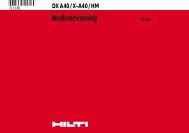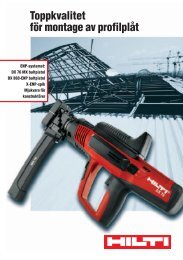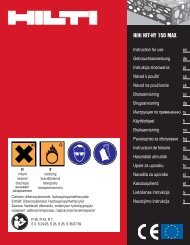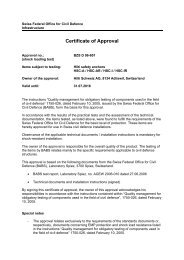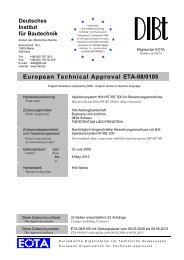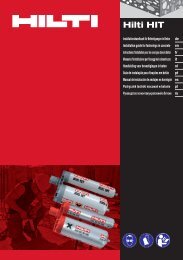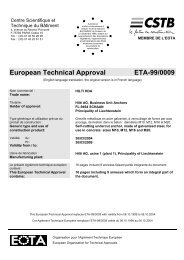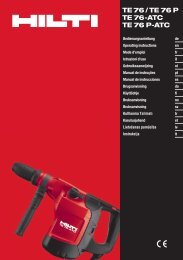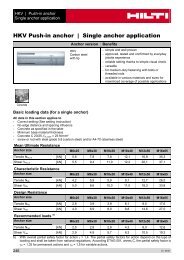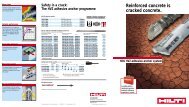00 Contents - Hilti Svenska AB
00 Contents - Hilti Svenska AB
00 Contents - Hilti Svenska AB
Create successful ePaper yourself
Turn your PDF publications into a flip-book with our unique Google optimized e-Paper software.
Steel base material<br />
5.2 Factors influencing pull-out resistance<br />
Powder-actuated fastening systems must be<br />
designed and manufactured to ensure that pullout<br />
resistance will be adequate for the applications<br />
intended. Through understanding of the<br />
anchoring mechanisms, experience and testing,<br />
factors that influence pull-out strength have<br />
been identified. Some of these factors are:<br />
• Depth of penetration in the base material<br />
• Surface characteristics of the fastener<br />
• Coatings on the steel base material<br />
• Driving velocity<br />
• Diameter of the fastener shank<br />
Depth of penetration in the base material<br />
The depth of penetration of fasteners in steel<br />
is taken as the distance that the point travels<br />
below the surface of the base steel, independent<br />
of the steel thickness. In other<br />
words the depth of penetration hET can be<br />
greater than, equal to or less than the steel<br />
thickness.<br />
Resistance to pull-out increases with<br />
increasing depth of penetration. This is also<br />
true for through-penetrating fasteners where<br />
hET is greater than the steel thickness.<br />
The design of a powder-actuated fastener<br />
has to take into account the depth penetration<br />
necessary to achieve the pullout resistance<br />
required for the application. Application<br />
guidelines published for any fastener<br />
include the required penetration depth.<br />
Knowledge of the influencing factors is vital<br />
to the design of fastening systems and is<br />
useful for operators in understanding the<br />
various application guidelines and restrictions<br />
that apply to a fastening system. Some<br />
of the influencing factors are discussed in<br />
the following section.<br />
Siding and decking pin X-ENP-19 L15•<br />
4.5 mm [0.177"] shank diameter<br />
23,8<br />
hNVS<br />
hET<br />
ΣtI,tot ≤ 4 mm<br />
1.36 11 / 2<strong>00</strong>7<br />
tII<br />
Nail for X-HVB composite connector<br />
X-ENP-21 HVB<br />
25,8<br />
hNVS<br />
tII<br />
hET



